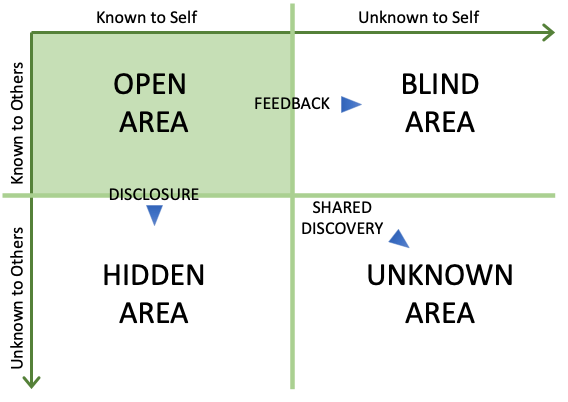
I am working with an organization that has many teams that report up through a couple of layers of management. The teams happen to be contracted, though for other organizations I have not seen it make a difference. The management, particularly the higher level of this management, does not seek feedback for the decisions they make or that they are making.
If you are a manager, it is important for you to get feedback on the options you have for the decisions at hand. This will help you know if other options can be considered and to understand the impact of the decisions you are making. The amount and type of feedback you request is important. Without this feedback, you may be making decisions in the blind. When you make them without seeking feedback, you are missing information on whether your choices will have a positive or negative impact on the people doing the work.
Before we dive into an example, let’s look at a long-standing model of people and knowledge about interpersonal awareness. The model displayed below is called the Johari window. It was first presented in a paper in 1955, but was really fleshed out further in a book called Of Human Interaction by Joseph Luft in 1969.

There are things you and others know about you; this is the open area. You know some things about yourself, but others don’t. This is the hidden area. You can choose to disclose what you want. There are areas unknown to both you and others, this is the unknown area and shared discovery is how they become known. The important area for this post is the blind area. This is an area others can see about you; they know the information AND you don’t. The way you discover this is through feedback.
This feedback could be solicited (you ask for it) or unsolicited (you didn’t). I don’t recommend anyone give unsolicited feedback; it’s best to ask if someone is interested in receiving it.
As a manager, you need to be open to receiving and asking for feedback from others (yes including people that report to you) for several reasons:
- It models this behavior for others; if you would like people open to receiving feedback from you, then you need to lead by example.
- This is a mechanism in how you determine how well you are doing as a manager. Getting regular feedback, both formally and informally, from above, below, and your peers gives you a complete picture.
- This is also how you can find out if your decisions will impact others negatively. If these happen to be the people that report to you, it may reflect negatively on your performance. You can choose to learn about these negative impacts as you consider the options for decisions or after you made a decision and hear about it from a different path (like your boss or a customer).
I am going to run through a short example of why it is important to ask for feedback on decisions. This is an extremely simple example.
Imagine you have 20 or so teams that suddenly started going remote due to COVID-19. The week after everyone went remote you held an all-hands meeting of all your staff and contractors (so everyone involved in those 20 or so teams and then some) and you gave them some information about going remote and wanting to help create an environment of helping people work together.
It went well enough and so you decide you want have another at some point. 6 1/2 weeks pass and so you schedule the next one in the 3 days. Now remember, everyone reports to you. Teams scramble to accommodate this decree; it has really disrupted what they now have as work rhythms, something they had not acquired one week into going all remote. At that earlier point in time, it was much less of a disruption.
What may have happened if you had for some feedback on this plan from team members with interest in actually learning the impact? It most likely would have revealed it would interfere with planned work. Does this mean you should abandon the idea of having an all-hands? Not at all. What it does do though is open up considerations of when you could schedule it and how much lead-time would allow teams to fit this into their plans more readily.
This all-hands is a simple example. Is the negative impact unrecoverable? Not at all… But the signals it sends are probably worse. It signals that being present to listen to you as the ‘boss’ is more important than the actual work (which was free to being disrupted). This can lower morale. Given you have some layers of management between you and the teams, it also says it is OK for them to do the same. Hmmm… now this effect is multiplying. Most likely you were blind to these effects.
And depending on context how many other seemingly simple decisions are made without soliciting feedback on them before they are made?
Some will claim well ‘Inspect and Adapt’ that is the agile way… That may be true and I would also say that more important in this circumstance is building the project around a motivated team and supporting them. Sincerely reaching out for feedback on this decision (even if you still end up making the same decision) in itself helps reduce the deflated motivation.
* “The Johari window, a graphic model of interpersonal awareness”. Proceedings of the western training laboratory in group development, Joseph Luft, Harrington Ingraham, 1955

